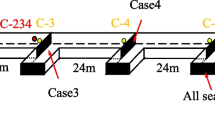Abstract
Based on numerical methods and theoretical analysis, the influence of the tunnel wall surface conditions on the methane-air explosion is evaluated. A rough tunnel wall causes stronger turbulence in the methane-air explosion. In a straight tunnel where some part of the space is filled with the methane-air mixture, the turbulence intensity varies with distance along the tunnel axis: it is higher in the methane-air premixing region and also in the far region of air shock wave propagation; between these regions, the turbulence intensity is lower. In the methane-air premixing region, the effect of turbulence is manifested as a significant increase in the explosion pressure. In the far region of air shock wave propagation, turbulence makes the shock wave strength decrease, but its effect is indistinctive among others. In the original methane-air premixing region, the explosion pressure of the methane-air mixture in a tunnel with rough walls is higher than that in a tunnel with smooth walls. However, the air shock wave beyond the premixing region in a tunnel with rough walls is weaker than that in a tunnel with smooth walls.
Similar content being viewed by others
References
D. M. Msiza, “The Review of the Flammable Gas and Coal Dust Explosions,” J. Min. Venti. Soc. S. Afr. 56(3), 119–122 (2003).
D. Bjerketvedt, J. R. Bakke, and K. V. Wingerden, “Gas Explosion Handbook,” J. Hazard. Mater. 52(1), 1150.
I. O. Moen, J. H. S. Lee, B. H. Hjertager, et al., “Influence of Obstacles on Flame Propagation and Pressure Development in a Large Vented Tube,” Combust. Flame 47, 3–52 (1981).
N. R. Popat, C. A. Catlin, and B. J. Arntzenb, “Investigations to Improve and Assess the Accuracy of Computational Fluid Dynamic Based Explosion Models,” J. Hazard. Mater. 45(1), 1–25 (1996).
B. Janovsky, P. Selesovsky, J. Horkel, et al., “Vented Confined Explosions in Stramberk Experimental Mine and AutoReaGas Simulation,” J. Loss Prev. Process Ind. 19(2–3), 280–287 (2006).
C. Zhai, B. Q. Lin, C. G. Guan, et al., “Influence ofWall Roughness on Flame Transmission of Gas Explosion,” J. China Univ. Min. Tech. 35, 39–43 (2006).
Y. B. Ding and Z. R. Guo, “Research Status of Flame Propagation of Combustible Gas under Conditions of Obstacles,” Ind. Saf. Envi. Prot. 32, 30–31 (2006).
L. Pang, Q. Zhang, and T. Wang, “Influence of Laneway Support Spacing on Methane/Air Explosion Shock Wave,” Saf. Sci. 50(1), 83–89 (2012).
M. W. Evans, “A Study of High Velocity Flames Developed by Grids in Tubes,” Symp. Combust. Flame Explos. Phenom. 3(1), 168–176 (1949).
I. O. Moen and M. Donato, “Flame Acceleration due to Turbulence Produced by Obstacles,” Combust. Flame 39(1), 21–32 (1980).
K. I. Shchelkin, “Gas Dynamics of Combustion,” Fiz. Goreniya Vzryva 4(4), 455–468 (1968).
G. C. Williams, H. C. Hottel, and A. C. Scurlock, “Flame Stabilization and Propagation in High Velocity Gas Streams,” Symp. Combust. Flame Explos. Phenom. 3(1), 21–40 (1949).
J. D. Xu, S. L. Xu, and G. Y. Yang, “Experimental Study on Mine Gas Explosion Diffusion,” Coal Sci. Technol. 32, 55–57 (2004).
Author information
Authors and Affiliations
Corresponding author
Additional information
Original Russian Text © Q.J. Ma, Q. Zhang, L. Pang.
__________
Translated from Fizika Goreniya i Vzryva, Vol. 50, No. 2, pp. 94–99, March–April, 2014.
Rights and permissions
About this article
Cite this article
Ma, Q.J., Zhang, Q. & Pang, L. Influence of the tunnel wall surface condition on the methane-air explosion. Combust Explos Shock Waves 50, 208–213 (2014). https://doi.org/10.1134/S0010508214020129
Received:
Published:
Issue Date:
DOI: https://doi.org/10.1134/S0010508214020129




